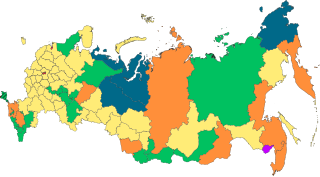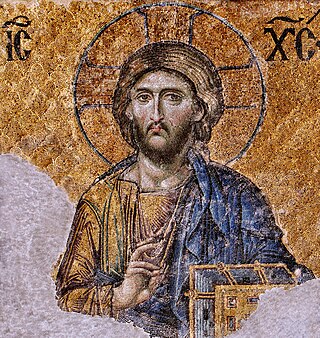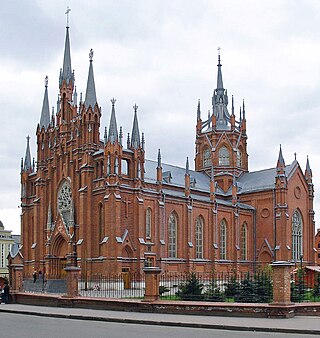
Moscow Oblast, also known as Podmoskovye, is a federal subject of Russia. With a population of 8,524,665 living in an area of 44,300 square kilometers (17,100 sq mi), it is one of the most densely populated regions in the country and is the second most populous federal subject. The oblast has no official administrative center; its public authorities are located in Moscow and Krasnogorsk, and also across other locations in the oblast.

Kostroma Oblast is a federal subject of Russia. Its administrative center is the city of Kostroma and its population as of the 2021 Census is 580,976. It was formed in 1944 on the territory detached from neighboring Yaroslavl Oblast.

Vologda Oblast is a federal subject of Russia. Its administrative center is Vologda. The oblast has a population of 1,202,444. The largest city is Cherepovets, the home of the Severstal metallurgical plant, the largest industrial enterprise in the oblast.

Arkhangelsk Oblast is a federal subject of Russia. It includes the Arctic archipelagos of Franz Josef Land and Novaya Zemlya, as well as the Solovetsky Islands in the White Sea. Arkhangelsk Oblast also has administrative jurisdiction over the Nenets Autonomous Okrug (NAO). Including the NAO, Arkhangelsk Oblast has an area of 587,400 km2. Its population was 1,227,626 as of the 2010 Census.

Novgorod Oblast is a federal subject of Russia. Its administrative center is the city of Veliky Novgorod. Some of the oldest Russian cities, including Veliky Novgorod and Staraya Russa, are located in the oblast. The historic monuments of Veliky Novgorod and surroundings have been declared a UNESCO World Heritage Site. Population: 634,111.

Bryansk Oblast, also known as Bryanshchina, is a federal subject of Russia. Its administrative center is the city of Bryansk. As of the 2021 Census, its population was 1,169,161.

Pomors or Pomory are an ethnographic group descended from Russian settlers, primarily from Veliky Novgorod, living on the White Sea coasts and the territory whose southern border lies on a watershed which separates the White Sea river basin from the basins of rivers that flow south.

Leningrad Oblast is a federal subject of Russia. It was established on 1 August 1927, although it was not until 1946 that the oblast's borders had been mostly settled in their present position. The oblast was named after the city of Leningrad. In 1991, the city restored its original name, Saint Petersburg, but the oblast retains the name of Leningrad. The capital and largest city is Gatchina.

Tula Oblast is a federal subject of Russia. It is geographically located in European Russia and is administratively part of the Central Federal District, covering an area of 25,700 square kilometers (9,900 sq mi). It has a population of 1,553,925 (2010 Census). Tula is the largest city and the administrative center of the oblast.

The federal subjects of Russia, also referred to as the subjects of the Russian Federation or simply as the subjects of the federation, are the constituent entities of Russia, its top-level political divisions according to the Constitution of Russia. Kaliningrad Oblast is the only federal subject geographically separated from the rest of the Russian Federation by other countries.

The Holodomor, also known as the Terror-Famine or the Great Famine, was a human-made famine in Soviet Ukraine from 1932 to 1933 that killed millions of Ukrainians. The Holodomor was part of the wider Soviet famine of 1932–1933 which affected the major grain-producing areas of the Soviet Union.

Spiritual Christianity is the group of belief systems held by so-called folk Protestants, including non-Eastern Orthodox indigenous faith tribes and new religious movements that emerged in the Russian Empire. Their origins are varied: some from Protestant movements imported from Europe to Russia by missionaries, travelers and workers; some due to disgust of the behavior of Orthodox priests; and, some from the Bezpopovtsy Raskolniks. These influences mixed with folk traditions, resulting in communities collectively called sektanty (sectarians). These communities were typically documented by Russian Orthodox clergy with a label that described their heresy: not fasting, meeting on Saturday (sabbatarians), rejecting the spirit, body mutilation (castigators), self-flagellation, suicide, and more.

Belarusians are a major ethnic group in Russia. At the census of 2010, 521,443 Russian citizens indicated Belarusian ancestry. Major Belarusian groups live in the regions of Moscow, St. Petersburg, Kaliningrad, Karelia and Siberia. Most Belarusians in Russia are migrants from modern Belarus or their descendants, while a minor part of Belarusians in Russia are indigenous.

The causes of the Holodomor, which was a man-made famine in Soviet Ukraine during 1932 and 1933, resulted in the death of around 3–5 million people. The factors and causes of the famine are the subject of scholarly and political debate, which include the Holodomor genocide question. Soviet historians, Stephen Wheatcroft and J. Arch Getty believe the famine was the unintended consequence of problems arising from Soviet agricultural collectivization which were designed to accelerate the program of industrialization in the Soviet Union under Joseph Stalin. Other academics conclude policies were intentionally designed to cause the famine. Some scholars and political leaders claim that the famine maybe classified as a genocide under the definition of genocide that entered international law with the 1948 Genocide Convention.

The Russian Empire was an empire and the final period of the Russian monarchy from 1721 to 1917, ruling across large parts of Eurasia. It succeeded the Tsardom of Russia following the Treaty of Nystad, which ended the Great Northern War. The rise of the Russian Empire coincided with the decline of neighbouring rival powers: the Swedish Empire, the Polish–Lithuanian Commonwealth, Qajar Iran, the Ottoman Empire, and Qing China. It also held colonies in North America between 1799 and 1867. Covering an area of approximately 22,800,000 square kilometres (8,800,000 sq mi), it remains the third-largest empire in history, surpassed only by the British Empire and the Mongol Empire; it ruled over a population of 125.6 million people per the 1897 Russian census, the only census carried out during the entire imperial period. Owing to its geographic extent across three continents at its peak, it featured great ethnic, linguistic, religious, and economic diversity.

The Russian Soviet Federative Socialist Republic, Russian SFSR or RSFSR, previously known as the Russian Soviet Republic and the Russian Socialist Federative Soviet Republic as well as being unofficially known as Soviet Russia, the Russian Federation or simply Russia, was an independent federal socialist state from 1917 to 1922, and afterwards the largest and most populous Soviet socialist republic of the Soviet Union (USSR) from 1922 to 1991, until becoming a sovereign part of the Soviet Union with priority of Russian laws over Union-level legislation in 1990 and 1991, the last two years of the existence of the USSR. The Russian SFSR was composed of sixteen smaller constituent units of autonomous republics, five autonomous oblasts, ten autonomous okrugs, six krais and forty oblasts. Russians formed the largest ethnic group. The capital of the Russian SFSR and the USSR as a whole was Moscow and the other major urban centers included Leningrad, Stalingrad, Novosibirsk, Sverdlovsk, Gorky and Kuybyshev. It was the first Marxist-Leninist state in the world.

Mezensky District is an administrative district (raion), one of the twenty-one in Arkhangelsk Oblast, Russia. As a municipal division, it is incorporated as Mezensky Municipal District. It is located in the northeast of the oblast and borders with Nenets Autonomous Okrug in the northeast, Ust-Tsilemsky District of the Komi Republic in the east, Leshukonsky and Pinezhsky Districts in the south, and with Primorsky District in the southwest. From the north, the district borders the White Sea. The area of the district is 34,400 square kilometers (13,300 sq mi). Its administrative center is the town of Mezen. Population: 10,330 (2010 Census); 13,124 (2002 Census); 17,796 (1989 Census). The population of Mezen accounts for 34.6% of the total district's population.
Leslie Clarence Dunn was a developmental geneticist at Columbia University. His early work with the mouse T-locus and established ideas of gene interaction, fertility factors, and allelic distribution. Later work with other model organisms continued to contribute to developmental genetics. Dunn was also an activist, helping fellow scientists seek asylum during World War II, and a critic of eugenics movements.
Political economy in anthropology is the application of the theories and methods of historical materialism to the traditional concerns of anthropology, including but not limited to non-capitalist societies. Political economy introduced questions of history and colonialism to ahistorical anthropological theories of social structure and culture. Most anthropologists moved away from modes of production analysis typical of structural Marxism, and focused instead on the complex historical relations of class, culture and hegemony in regions undergoing complex colonial and capitalist transitions in the emerging world system.
Stephen Porter Dunn was a U.S. anthropologist specializing in ethnic groups of the Soviet Union. He translated and edited a number of works on the topic from the Russian language, and lectured in several universities. Apart from his involvement with academia, he was a poet and issued several collections of verse.















